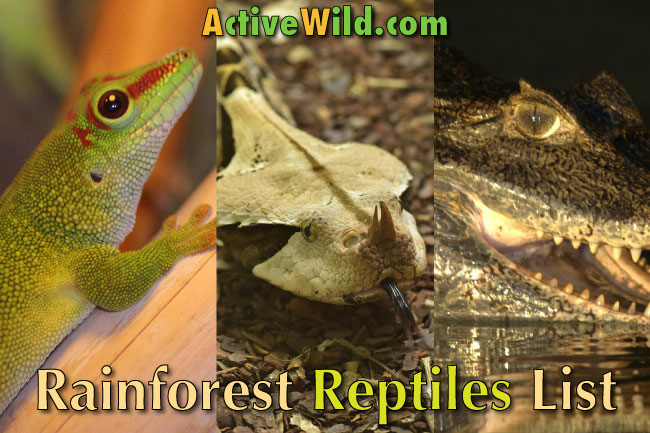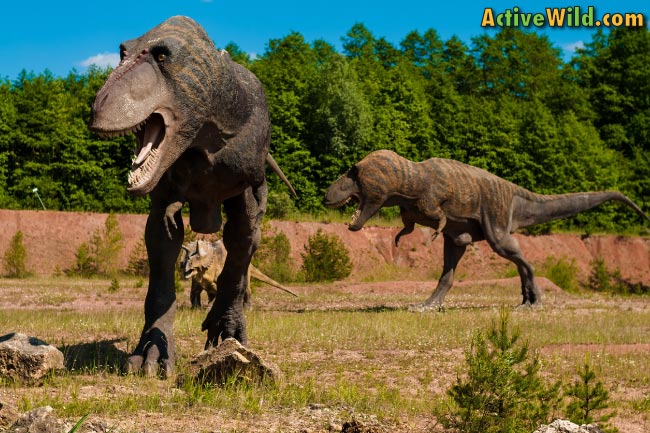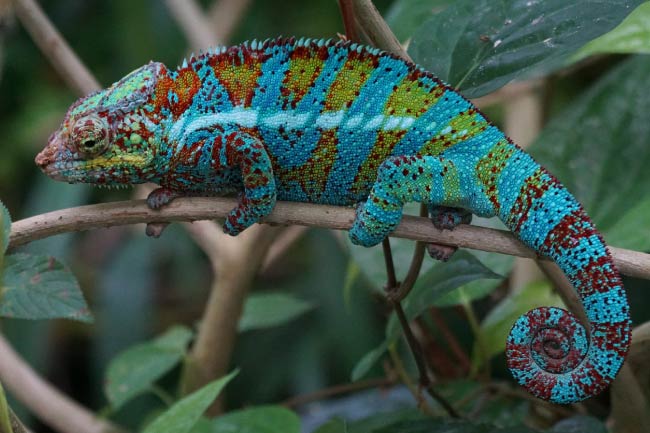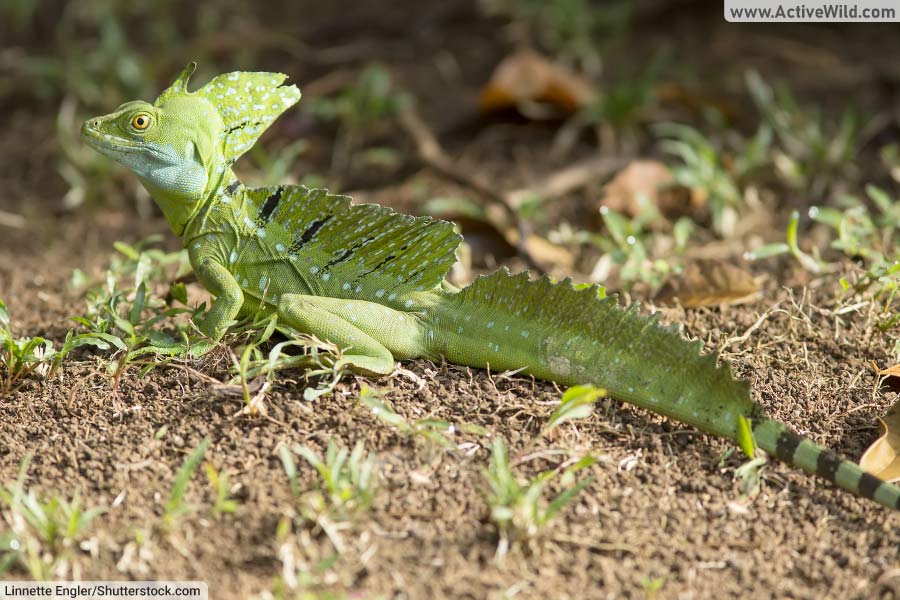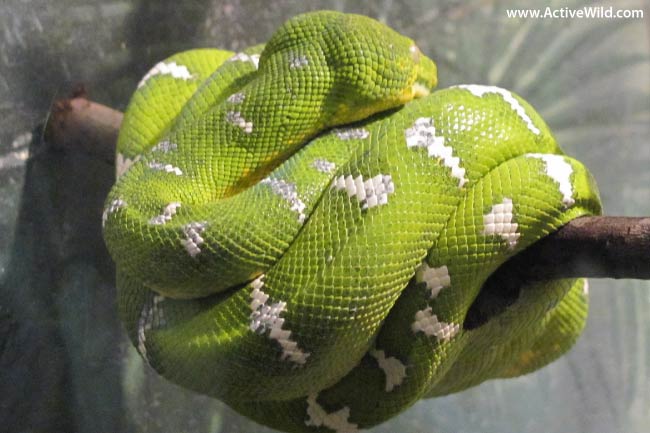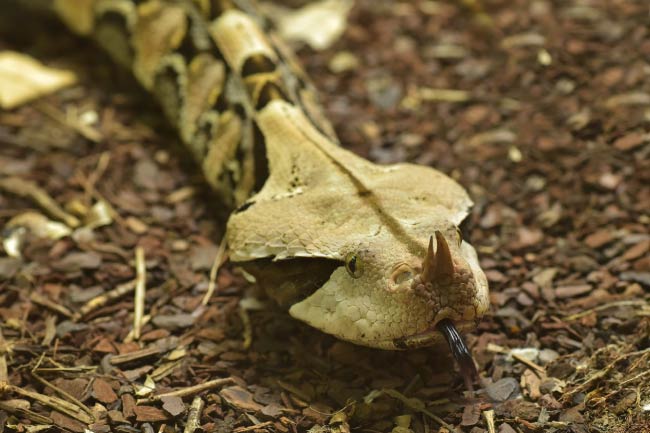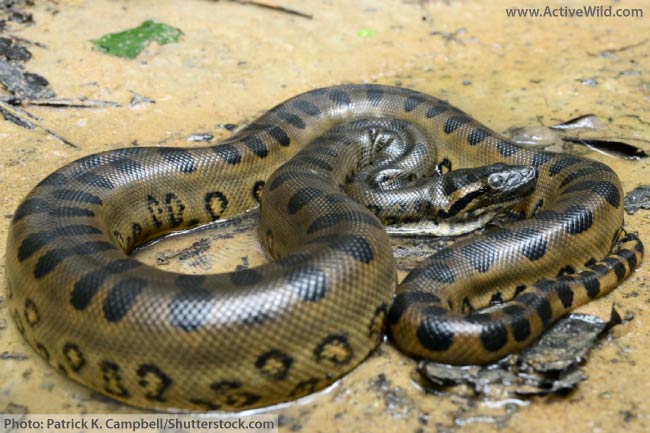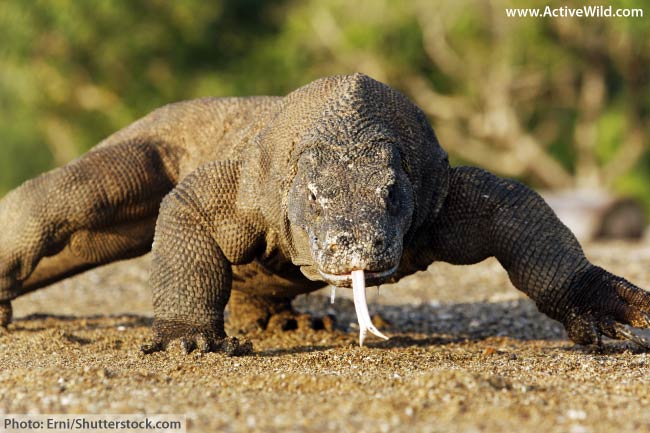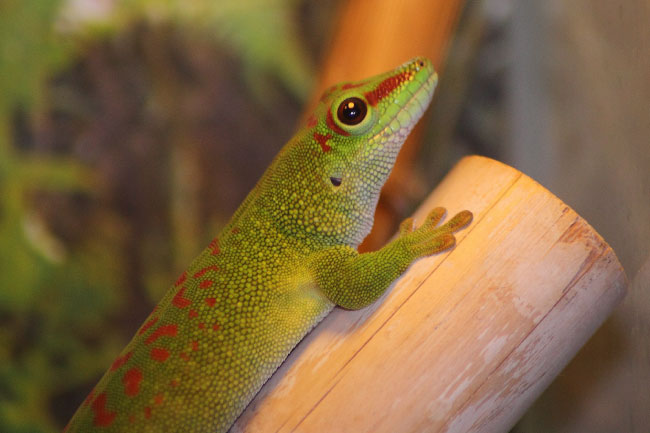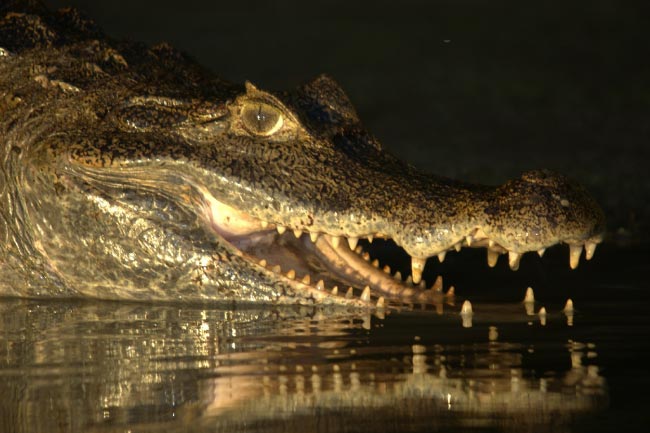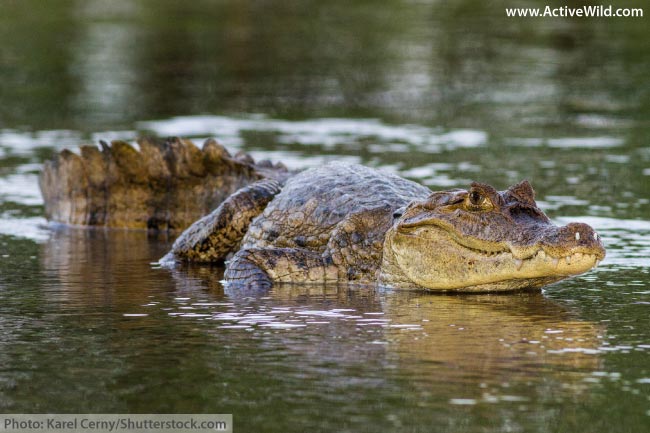Rainforest reptiles list, with facts and pictures. Discover the amazing reptiles that live in the world’s tropical rainforests, including deadly snakes, flying lizards, and fearsome crocodilians!
Tropical Rainforest Reptiles List: Introduction
Reptiles are members of the animal class Reptilia. Reptiles first appeared around 300 million years ago. During the Mesozoic Era reptiles – in the shape of dinosaurs – were the dominant land animals.
All this changed around 66 million years ago, when the Cretaceous–Paleogene extinction event caused the extinction of the dinosaurs. (Well, not all of them; some dinosaurs evolved into birds.)
- If you want to find out more about dinosaurs, check out our dinosaur section!
- Want to be an reptile expert? Visit our Reptile Section
Although mammals filled many of the niches previously taken by the dinosaurs, reptiles didn’t disappear entirely. In fact, early turtles, snakes and crocodiles co-existed with the dinosaurs. These groups didn't become extinct at the end of the Mesozoic Era. Their descendants are still around today, relatively unchanged.
What is a Reptile?
Reptiles are cold-blooded, air-breathing animals with scaly skin. The majority of reptiles lay eggs, but some give birth to live young.
Rainforest Reptiles
The world’s rainforests are home to many amazing reptiles. On this page you’ll find a list of tropical rainforest reptiles. These species live in warm, moist forests located on or near the Equator.
The reptiles on this page reflect the wide variety of species in Reptilia, from turtles to flying snakes – and everything in-between!
- You can find out about more rainforest animals (including more reptiles) here: Rainforest Animals List.
- Discover some amazing rainforest mammals here: Rainforest Mammals List.
- Become an animal expert! Visit our main animals page: Animals: The Ultimate Guide.
List of Rainforest Reptiles with Pictures & Facts
Under the name of each animal you'll find the scientific name of the species in italics. If it's a group of species, we've included the type of group (e.g. genus, family, etc.) and the group name (not in italics).
Arrau turtle
(Also known as: Arrau River turtle, South American river turtle, Giant South American turtle)
Podocnemis expansa
- Where found: South America
- Conservation status: Least Concern
The Arrau turtle lives in the rivers and streams of the Amazon Basin – the area of land that drains into the Amazon River.
The Arrau turtle is the world’s largest side-neck turtle. Side-neck turtles, or Pleurodira, are one of the two groups of turtles, the other being the hidden-necked turtles, Cryptodira.
Side-neck turtles hide their necks in their shells by bending their necks sideways. (Cryptodires withdraw their heads straight back between their legs.)
Arrau turtles are herbivores (plant-eaters). Large numbers of Arrau turtles gather at certain locations during the breeding season, and the females leave the water at night to lay their eggs.
Although the conservation status of the Arrau turtle is ‘Least Concern’, it is dependent on human conservation efforts.
Common Basilisk
(Also known as: Jesus lizard, Jesus Christ lizard)
Basiliscus basiliscus
- Where found: South America
- Conservation status: Least Concern
This South American rainforest lizard is famous for its ability to run over the surface of water. This ability gives the common basilisk its other name of ‘Jesus lizard’.
The common basilisk is a large lizard, growing to around 75 cm (2.5 ft.) long. Its tail comprises 75% of its length. The basilisk’s skin is usually olive-brown, and marked with darker stripes.
Male common basilisks are larger than females, and have ‘sails’ (flaps of skin) on their heads, backs and tails.
The common basilisk is an excellent climber and swimmer, but is best known for its ability to run on water. If threatened, the lizard will sprint away on its hind legs.
The common basilisk will continue to flee by running across the surface of any water that is nearby. It is held up by its large feet, which are equipped with flaps of skin. Eventually the lizard sinks below the surface, where it will continue to swim until the threat has passed.
Emerald Tree Boa
Corallus caninus
- Where found: South America
- Conservation status: Least Concern
The emerald tree boa is found in the rainforests of South America, including the Amazon rainforest. It is arboreal (i.e. it lives in trees) and nocturnal (active at night).
Like all boa snakes, the emerald tree boa is non-venomous. It subdues its prey by wrapping its body around the prey animal, preventing it from breathing.
The emerald tree boa grows to around 1.8 m (6 ft) in length. Individuals found in the Amazon rainforest are larger, reaching lengths of around 2.7 m (9 ft).
The emerald tree boa gives birth to live young rather than laying eggs. Females give birth to between 6 and 14 young in one litter.
Flying Lizard
(Also known as: Flying Dragon, Gliding Lizard)
Genus: Draco
- Where found: Asia
There are several species of flying lizard in the genus Draco. They are found in the forests of Southeast Asia.
(A genus is a group of closely related animals. If you want to find out more about how animals are grouped, have a look at our Animal Classification page.)
Although flying lizards can only glide rather than actually fly, they are capable of travelling distances of up to 60 m (200 ft) in the air.
Flying lizards only set foot on the ground to lay their eggs. These insect-eating reptiles spend the rest of their lives in the trees.
Flying Snake
Chrysopela paradise
- Where found: Asia
- Conservation status: Least Concern
There are five recognized species of flying snake in the genus Chrysopelea. They are found in the forests of Southeast Asia.
Flying snakes glide rather than fly. In order to glide they flatten their bodies and ‘swim’ through the air. This is a more efficient way of travelling from tree to tree than going down to the forest floor and climbing back up into the canopy again.
Flying snakes are mildly venomous, but are not dangerous to man. They hunt small animals such as lizards, rodents, birds and bats.
Gaboon Viper
Bitis gabonica
- Where found: Africa
- Conservation Status: Not Assessed
The Gaboon viper lives in the rainforests of western Africa, and is one of the most dangerous rainforest reptiles. It is the world’s heaviest viper, growing, on average, to around 155cm (61 in) in length.
This deadly rainforest snake not only has the longest fangs of any snake but also carries the largest amount of venom of any snake.
Luckily, due to its African rainforest habitat and docile nature, it rarely attacks humans. However, a bite from the Gaboon viper is potentially fatal.
The main prey of the Gaboon viper is rodents and birds. It is an ambush predator, waiting for its prey to approach before striking. The green and black patches on its skin provide excellent camouflage.
Green Anaconda
Eunectes murinus
- Where found: South America
- Conservation Status: Not Assessed
The green anaconda is the world’s heaviest snake and the world’s second longest snake. Females are larger than males, growing to lengths of around up to 8m (26 ft). The average length is around 4.6 m (15.1 ft).
The green anaconda has an aquatic lifestyle and is an excellent swimmer. It spends most of its life in rainforest rivers, streams and lakes.
The green anaconda is a member of the Boidae (boa) family of snakes. Like all members of this family, it is non-venomous. Instead of injecting its victims with poison, it squeezes them, preventing them from breathing. We’re not sure which is worse!
Green Iguana
iguana iguana
- Where found: South America
- Conservation Status: Not Assessed
Despite its fearsome looks the green iguana is mainly herbivorous. Its range stretches from the south of Brazil north to Mexico. It has also been introduced in areas of Florida and Texas.
Despite its name, the green iguana can be pink, blue, black and a variety of other colors, as well as its more usual green. Iguanas from the same region tend to be the same color.
The green iguana is arboreal (tree-dwelling), spending most of its life in the canopy. Here it feeds on leaves and flowers.
The green iguana often lives by water. If threatened, it will dive out of its tree into the safety of the water. It is a good swimmer, propelling itself with its long tail.
Komodo Dragon
Varanus komodoensis
- Where found: Asia
- Conservation Status: Vulnerable
The Komodo dragon is the world’s largest lizard. It grows to lengths of up to 3 m (10 ft). This fearsome rainforest reptile lives on the Indonesian islands of Komodo, Rinca and Flores.
The Komodo dragon is a carnivore. It mostly eats carrion, but will also actively hunt for prey. Its diet includes birds, reptiles (including other Komodo dragons), and mammals. Even larger animals such as deer, water buffalo and pigs can be targeted.
The Komodo dragon is cold-blooded, and has a slow metabolism. Because of this, one large meal is all it needs for several weeks.
Madagascar Giant Day Gecko
Phelsuma grandis
- Where found: Madagascar
- Conservation status: Least Concern
The Madagascar giant day gecko is found in the tropical rainforests of Madagascar. It is one of the largest geckos, reaching around 28 cm (11 in) in length. Its body is bright green, and covered in red dots and stripes. There are two red strips on either side of its face.
Like most geckos, the Madagascar giant day gecko lacks eyelids. It keeps its eyes lubricated by licking them with its tongue.
The Madagascar giant day gecko is arboreal, and active during the day. It is mainly insectivorous (insect-eating), but will also eat small vertebrates and nectar from flowers.
Orinoco Crocodile
Crocodylus intermedius
- Where found: South America
- Conservation Status: Critically Endangered
The Orinoco crocodile is one of the largest crocodilians of the Americas. (It vies for the title of largest crocodilian of the Americas with the black caiman and American crocodile.) Adult males (the larger of the two sexes) can grow to 5.2 m (17 ft) in length.
The species can be identified by its long snout and pale brown color.
The Orinoco crocodile is found in the Orinoco River in Venezuela and Colombia. It is an apex predator and an opportunistic hunter, feeding on just about whatever gets within reach of its powerful jaws. Its diet includes fish, reptiles, birds and mammals.
The Orinoco crocodile is critically endangered. It was hunted almost to extinction for its skin, and its young are still being captured for sale to the pet industry. Pollution and habitat loss have also contributed to the Orinoco crocodile’s decline.
Panther Chameleon
Furcifer pardalis
- Where found: Madagascar
- Conservation status: Least Concern
Chameleons are lizards famous for their ability to change color. There are over 200 species of chameleon, and they are found in a variety of warm habitats.
One of the most colourful animals in this rainforest reptiles list is the panther chameleon. It lives in the tropical rainforests of Madagascar. It grips onto twigs and branches with its pincer-like feet and walks with the chameleon’s characteristic swaying motion.
Males grow to around 43 cm (17 inches) in length; females are around half the size. Its colorful body is covered in a variety of stripes and spots.
Spectacled Caiman
Caiman crocodilus
- Where found: South America
- Conservation status: Least Concern
The spectacled caiman is found in many parts of South and Central America. It has a bony ridge between its eyes, making it appear to be wearing spectacles, which is how it got its common name.
Male spectacled caimans grow to around 2.5 m (8.2 ft) in length. Females are smaller.
Caimans, like most crocodilians, are opportunistic hunters, snapping up any animal the gets within range of their powerful jaws.
The spectacled caiman is the most common crocodilian.
Western Bush Viper
(Other names: West African Leaf Viper, West African Tree Viper)
Atheris chlorechis
- Where found: Africa
- Conservation status: Least Concern
The western bush viper is a mid-sized viper that lives in the rainforests of western Africa. It is a birght green color, and has numerous yellow dots running along its back.
Like all vipers, the western bush viper has a pair of hollow fangs that are used to inject venom. The fangs fold back into the mouth when not in use.
Rather than laying eggs, the western bush viper gives birth to live young. Its diet includes small vertebrates such as rodents and lizards.
Tropical Rainforest Reptiles List: Conclusion
We hope that you've enjoyed finding out about the different types of reptiles that live in tropical rainforests.
Now that you've met some rainforest reptiles, why not discover more about the mammals that live in rainforests: Rainforest Mammals List ...
… or become an animal expert by visiting our main animals page: Animals: The Ultimate Guide. It's full of fun facts and amazing pictures. You can also download a free activity sheet to test your knowledge!
Discover more amazing reptiles on these pages:

